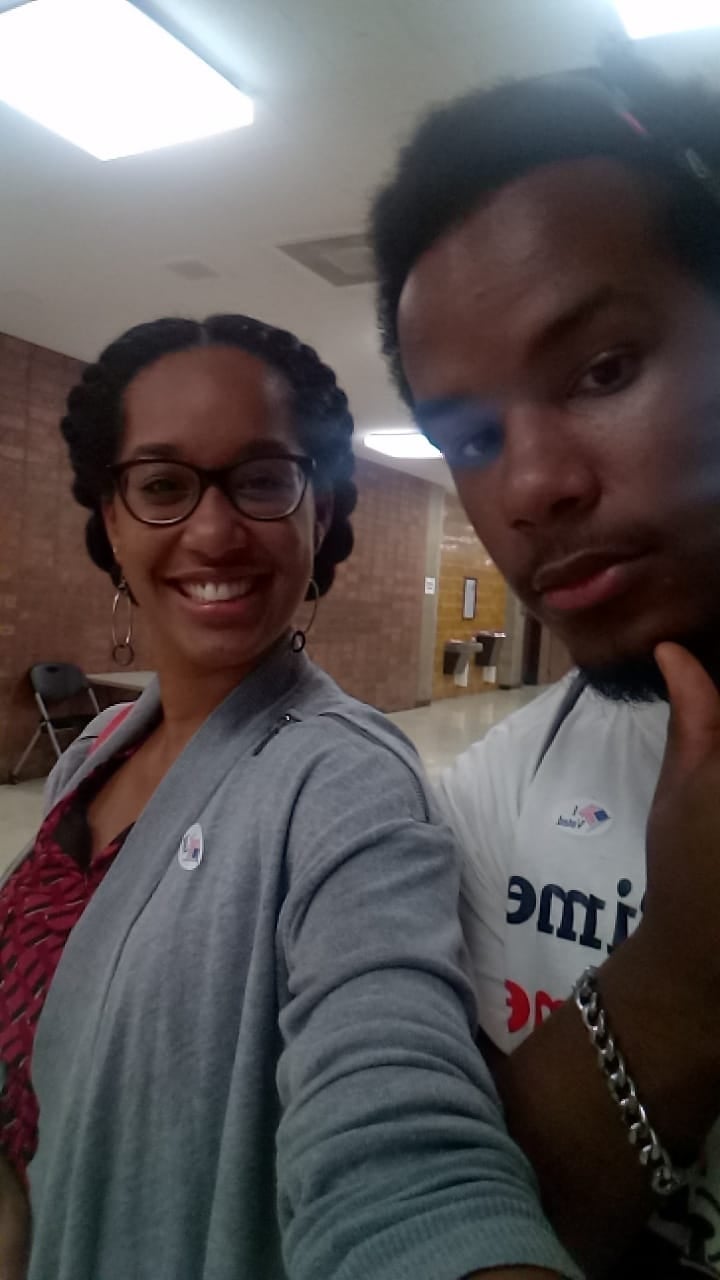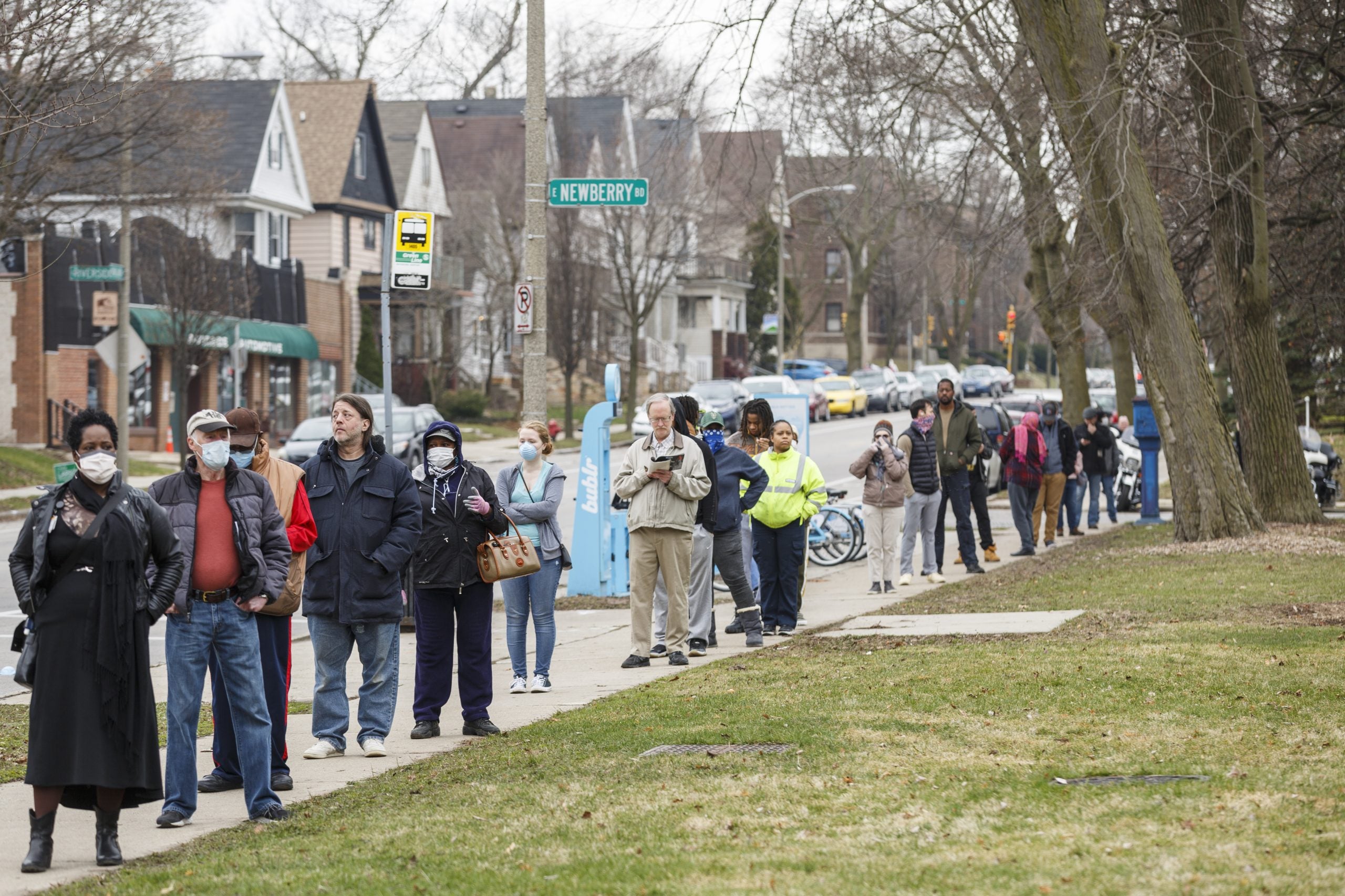The lines were long and went on for blocks on April 7 with people waiting patiently while donning face masks due to the coronavirus. But this is the fate Wisconsin voters were dealt after two court decisions surrounding the Wisconsin primary elections.
In one decision, the conservative-majority Wisconsin Supreme Court ruled along ideological lines that the elections would go forward as usual on April 7, despite the country being in the middle of a pandemic where social distancing has not only been highly encouraged but issued as an order across many states – including Wisconsin itself. This decision blocked Gov. Tony Evers’ executive order which sought to delay the election until June and also occurred at the 11th hour on Monday evening, mere hours before polls were scheduled to be opened.
Shortly after, the United States Supreme Court (also along ideological lines) reversed a lower court’s ruling that would have given Wisconsin voters an additional six days to mail in their absentee ballots, mandating instead that the ballots had to be postmarked by election day and arrive by April 13 in order to be counted. On that Monday morning, of the nearly 1.3 million absentee ballots requested, some 550,000 had not yet been returned.
Voters who spoke to ESSENCE recounted their confusion, frustration, anger and, for some of them, the heartbreaking decision not to vote in the midst of a health crisis that has sickened more than half a million people living in the US and killed more than 30,000 thus far.

For those who showed up to the polls, they were met with long lines and questionable social distancing practices, especially in Milwaukee – where, of the normally 180 polling locations – only five were open.
Dora Drake went with her brother to the polls at around 6:50 a.m. on Tuesday morning in the hopes of beating the crowd. When they got to their polling location in Marshall High School, the line was already two blocks long. They never left until around 8:30 a.m.

Then Drake decided to return to offer support to those waiting in line, to make sure that voters weren’t being discouraged or given wrong information.
“The line was even longer,” the 27-year-old, who works for re-entry services told ESSENCE. “At this point, the line wrapped in and around the parking lot, down the sidewalk and it was probably was about two to four blocks long of people waiting in line, in person. The cars that were waiting in line, it was probably about five blocks. It was a lot of people still waiting in line. The last person that voted in person didn’t leave until I want to say around 10:30 p.m.”
Jasmine Johnson who is five months pregnant didn’t take kindly to the court’s decision.
“I just felt disrespected, I guess,” Johnson told ESSENCE. “None of it made sense. You tell us to practice social distancing and to quarantine ourselves. Then you squish a whole bunch of us in close quarters at like five polling locations. None of it made sense. It just seemed super very poorly planned and huge lack of care for anyone’s safety and that’s what we elected them for.”
Johnson recently received her voter registration form in the mail, and with everything unfolding just before the elections, she would have had to go in person to register to vote. She had hoped the elections would have been postponed, or at least that officials would have taken steps to ensure that every resident had access to an absentee ballot. As things stood, for the health of her child, as well as her own safety, she opted not to vote all.
This was a really tough decision for the 30-year-old from Milwaukee, who has prided in herself in never missing a vote prior to this.
“It was really disappointing and sad. I actually thought about it for a couple of weeks out about taking the risk with like gloves and a mask or maybe even a hazmat suit, but I just couldn’t take that risk and it was hard because I’ve never missed a vote,” she explained. “It might sound silly, but no matter how disillusioned I’ve become with the system, it’s always been a point of pride for me being able to vote just because so many of my female and Black ancestors weren’t able to.”
Johnson isn’t the only one who had to not vote out of real fear for her health.
Shavonda Sisson, 39, the Director of Ally and Alumni Programming of Public Allies Milwaukee, a social justice organization focused on helping young leaders hone their talents, ended up not being able to vote either.
Sisson is asthmatic and has been under strict quarantine in order to protect her health. As a result, she requested an absentee ballot mid-March, but it never showed up. As she attempted to track it on the website, her request never even showed up. Her husband, who requested his ballot on the same day, received mail with a return envelope in it, but no ballot.
“I’m not sure what happened. It’s inconceivable to me that something as important as protecting voter rights would be handled so carelessly,” Sisson said. “Mine not even registering to be sent out was one thing but I think to receive an envelope with no ballot in it, I can’t even figure out which is the most egregious.”

“My husband, he didn’t want to risk going out and him possibly getting sick or possibly bringing something back into the home. So, we were not able to vote,” she added.
University of Wisconsin-Stout student LaResha Love was able to vote absentee but expressed her frustration at the process, especially given that many of the younger generations are often asymptomatic if they do contract the virus.
“It makes me really emotional because it’s like why do we have to choose between our health and politics?” said Love, who works with the school’s Stout Reach program and Stout Student Association to help with student civic engagement, among other community initiatives
“It makes me feel like no one actually cares or it’s a joke,” the 20-year-old Milwaukee native, who also works with Leaders Igniting Transformation added. “It’s just very heartbreaking because we are trying to make a difference and we are trying to become better. The youth voting rate has gone up in the past few years like we are making that change and we’re making that step forward, but it just feels like we get knocked back like when something big happens like this.”
Milwaukee Mayor Tom Barrett told the Milwaukee Journal Sentinel that locations were chosen because of the need for enough space to maintain social distancing while criticizing Republican state legislators who insisted on pushing forth with an in-person election.
“I asked not to do this,” he said of the Tuesday elections. “I knew there would be problems. And there were problems.”
And indeed, there were many problems, not just in Milwaukee, but across the state of Wisconsin where now voters are considering the long-term repercussions of having to pick between their vote and their health.
“Although understanding the importance of [this election], but then also knowing that people decided to take that risk, it made me very sad in thinking about what could possibly happen in Milwaukee in the next two weeks, Sisson said. “We could see a new spike in cases that could be tied directly to folks standing outside of their polling places.”

It is a grim concern as we still face a lot of uncertainty when it comes to the spread of the coronavirus in the country, and as we look ahead to the 2020 elections and beyond. And leads to the question of, what can we learn from what happened in Wisconsin to make sure that this kind of frustration, this kind of voter suppression, quite frankly, never occurs again.
“[What happened in Wisconsin is a] travesty of our democracy, in that it was a preventable one,” Emma Greenman, the Center for Popular Democracy’s Director of Voting Rights and Democracy told ESSENCE. “It’s also a clear warning sign of what could happen in November in many states across the country if we don’t do the planning and state leaders don’t actually make the adjustments and changes that we need to ensure that elections can be conducted both safely and fairly during these pandemic conditions.”
“Election infrastructure is set up based on in-person voting, based on in-person voting and sometimes, early voting with some absentee. Wisconsin really showed what’s going to happen if we don’t actually make… adjustments, and quickly, so that every person can get a ballot, and that we can keep voters and election judges safe in an unprecedented moment,” Greenman added.
Of course, there are the different stimulus packages being passed through Congress, working in provisions to help states administer elections as safely and fairly as possible, however, more money than the is going to be needed to ensure that this is done properly. Some $400 million was allocated in the last stimulus package, however, it’s going to take between $2 and $4 billion for states to have the support they need, Ashley Allison, the EVP of Campaigns and Programs at The Leadership Conference told ESSENCE.
Those funds should then, in turn, go toward creating opportunities for early voting, and to send out ballots with return postage, to create online voter registration systems, all while maintaining digital options to help bridge the digital divide, among other measures.
“People can go and vote by mail, people can go and vote early, people can pick which way they want to vote, but we also want to make sure that it is equitable…and fair so that all voters can stay safe,” she said.
“November is seven months away and we have enough time to do it, but we need to act now. States have to start making their plans for November now. And they cannot wait until the summer,” Allison cautioned. “They cannot wait until October or else you’ll have a repeat of what we saw and Wisconsin and nobody wants that.”

